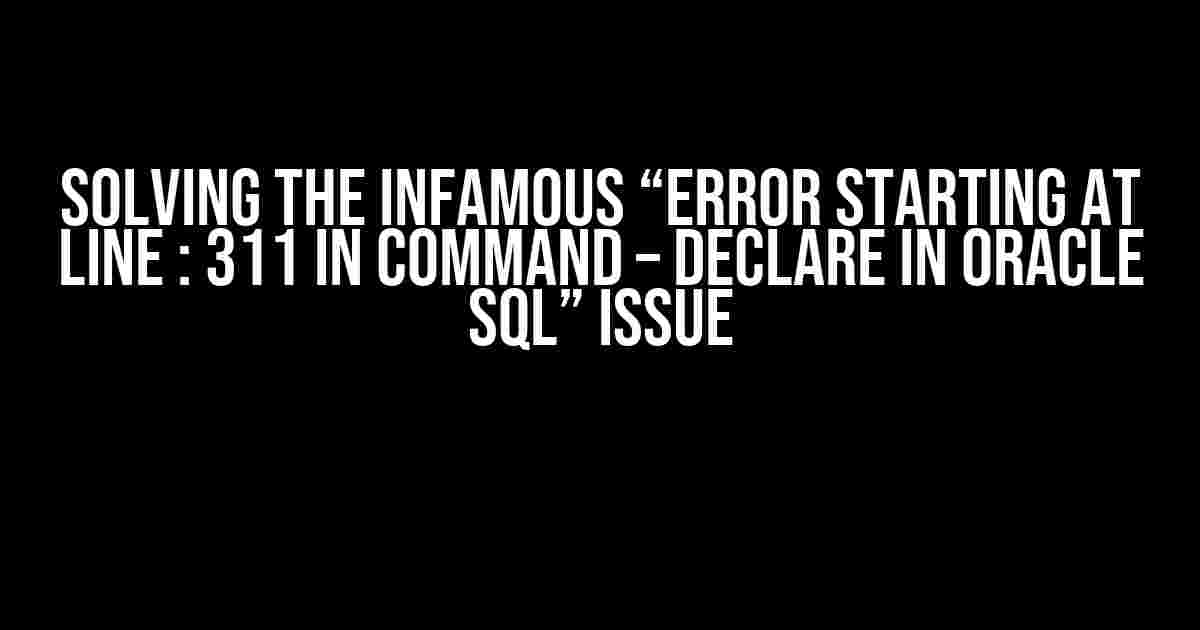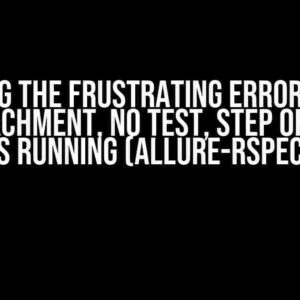If you’re reading this, chances are you’ve stumbled upon one of the most frustrating errors in Oracle SQL: “Error starting at line : 311 in command – DECLARE”. Don’t worry, you’re not alone! This pesky error has been driving developers and DBAs crazy for years. But fear not, dear reader, for we’re about to embark on a journey to conquer this beast and get your Oracle SQL queries running smoothly.
What causes the “Error starting at line : 311 in command – DECLARE”?
Before we dive into the solution, let’s take a step back and understand what’s causing this error. The infamous line 311 error typically occurs when there’s a syntax error or mismatch in your Oracle SQL code, specifically within a DECLARE statement. This can be due to a variety of reasons, such as:
- Syntax errors: Missing or mismatched keywords, brackets, or semicolons.
- Incorrect data types: Declaring variables with incompatible data types.
- Scope issues: Variables or cursors declared outside their intended scope.
- Version compatibility: Oracle SQL versions can have different syntax requirements.
Step-by-Step Troubleshooting Guide
Now that we’ve identified the potential causes, let’s follow a structured approach to diagnose and fix the issue:
-
Review your code: Take a closer look at your Oracle SQL code, paying attention to the DECLARE statement and surrounding lines. Check for any syntax errors, typos, or inconsistencies.
-
Check the error message: Oracle provides a detailed error message, including the line number and error description. Study this message to understand what’s causing the error.
-
Simplify your code: Temporarily remove or comment out complex sections of code to isolate the issue. This will help you identify the problematic area.
-
Verify data types: Ensure that your variable declarations match the intended data types. Use Oracle’s built-in data type conversion functions if necessary.
-
Scope and variable naming: Double-check that your variables and cursors are declared within the correct scope and follow Oracle’s naming conventions.
-
Test individual sections: Break down your code into smaller sections and test each one individually to identify the faulty component.
-
Consult Oracle documentation: Refer to Oracle’s official documentation for specific syntax requirements and best practices for your Oracle SQL version.
Common Scenarios and Solutions
Let’s explore some common scenarios that might cause the “Error starting at line : 311 in command – DECLARE” and their corresponding solutions:
| Scenario | Solution |
|---|---|
| Missing semicolon after DECLARE statement | Add a semicolon at the end of the DECLARE statement DECLARE v_variable VARCHAR2(50); |
| Incorrect data type declaration | Ensure that the variable data type matches the intended data type DECLARE v_number NUMBER; |
| Scope issue with cursor declaration | Declare the cursor within the correct scope, such as within a procedure or function BEGIN ... DECLARE cur_cursor SYS_REFCURSOR; ... END; |
| Incompatible data type conversion | Use Oracle’s built-in data type conversion functions, such as TO_CHAR() or TO_NUMBER() DECLARE v_char VARCHAR2(50) := TO_CHAR(v_number); |
Example Code: A Simple DECLARE Statement
DECLARE
v_employee_name VARCHAR2(50) := 'John Doe';
v_salary NUMBER := 50000;
BEGIN
DBMS_OUTPUT.PUT_LINE('Employee Name: ' || v_employee_name);
DBMS_OUTPUT.PUT_LINE('Salary: ' || v_salary);
END;
In this example, we’ve declared two variables, v_employee_name and v_salary, with their respective data types. We’ve then used these variables within the BEGIN block to demonstrate their usage.
Conclusion
The “Error starting at line : 311 in command – DECLARE” can be a frustrating experience, but by following this step-by-step guide and understanding the common scenarios and solutions, you’ll be well-equipped to tackle this issue and get your Oracle SQL queries running smoothly. Remember to simplify your code, verify data types, and consult Oracle documentation when needed. Happy coding!
If you’re still stuck, feel free to share your code and error message in the comments below, and I’ll do my best to assist you.
Frequently Asked Question
Are you stuck with the infamous “Error starting at line: 311 in command – DECLARE in Oracle SQL” error? Worry not, friend! We’ve got you covered with the most commonly asked questions and answers to get you back on track.
Q1: What does the error “Error starting at line: 311 in command – DECLARE in Oracle SQL” even mean?
This error typically occurs when there’s a syntax issue or invalid statement in your Oracle SQL code, specifically around the DECLARE command. Oracle is pointing to line 311 as the culprit, but it might not always be the exact line causing the issue. Don’t worry, it’s just Oracle’s way of saying, “Hey, I found a problem, buddy!”
Q2: How do I troubleshoot this error?
To troubleshoot, start by reviewing your code around line 311 (and surrounding lines). Look for any syntax errors, missing keywords, or incorrect data types. You can also try commenting out sections of code to isolate the issue. If you’re still stuck, consider re-running your code in smaller chunks or using an Oracle IDE to identify the problem area.
Q3: Is it possible that my database version is causing the issue?
Yes, it’s possible! Different Oracle database versions can have varying levels of support for certain features or syntax. If you’re using an older version, you might run into compatibility issues. Make sure you’re using the correct database version that aligns with your code requirements. You can check the Oracle documentation for version-specific syntax and features.
Q4: Can I use an online compiler or IDE to test my code?
Absolutely! Online compilers and IDEs like Oracle Live SQL, DB<>fiddle, or Oracle SQL Developer can be super helpful in identifying errors and testing your code. These tools often provide real-time syntax checking, formatting, and error reporting. Try copying and pasting your code into one of these tools to see if it highlights the issue.
Q5: What if I’m still stuck after trying all the above steps?
Don’t give up, friend! If you’ve tried all the above steps and still can’t resolve the issue, consider reaching out to an Oracle community forum, online support group, or seeking help from a database administrator or developer. They can provide more specific guidance or help you pinpoint the problem. Remember, troubleshooting is a process, and sometimes it takes a fresh set of eyes to spot the issue.




